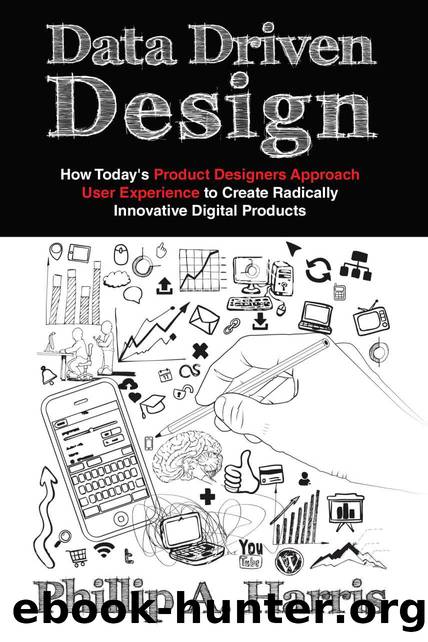Data Driven Design: How Today's Product Designer Approaches User Experience to Create Radically Innovative Digital Products by Phillip A. Harris

Author:Phillip A. Harris [Harris, Phillip A.]
Language: eng
Format: mobi
Tags: Introduction to User Experience
Publisher: K & R Publications
Published: 2013-01-12T00:00:00+00:00
Chapter 6
UX Psychology IIâWhy Users Settle for Less
The presentation of too many choices is often the bane of digital design. With a brand new TV, this might happen with the menus for picture quality. When the user gets the TV home and turns it on, he gets a pale imitation of the sharp, bright screen he saw in the store. No problem. A display is already appearing, inviting him to begin the setup. The user clicks through screens for color, brightness, contrast, hue, and so on.
Instead of leading to simple controls, each of these takes him to a screen with more specialized choices. This might be fun for a visual designer, but our user is an accomplished pianist who wouldnât know UX from UI. The user studies several items, and quickly feels acute data overload. He tries different settings, but each only makes things worse. As confusion overtakes him, he finds himself paralyzed by indecision. Finally, he concludes that the default picture is fine.
A year later, his new girlfriend asks him: âCouldnât we brighten that screen up a bit?â
âI guess so,â he says, his subconscious knocking up against vaguely unpleasant memories. âBut I kinda like it the way it is.â
This is a classic example of cognitive dissonance, or, as Merriam-Webster defines it: âpsychological conflict resulting from incongruous beliefs and attitudes held simultaneously.â The term originated with social psychologist Leon Festinger who coined it in 1957 to describe the behavior of a UFO cult whose supposed extraterrestrials failed to cause Armageddon on schedule. The cult leader said these visitors had found us wanting, and theyâd decided on a mercy killing. Only members of his cult would be spared. He set a date, told all his followers, and let the media in on it as well. When that date arrived, and the world kept on spinning, the cultists shrugged off all hints of embarrassment, telling skeptics that the Aliens had merely postponed the cataclysm. According to this revised theory, the cosmic visitors wanted to give the cultists time to warn the rest of us that we better shape up. These Aliens must be a patient lot. After 55 years, with no measurable improvement in human behavior, theyâre still biding their time. Maybe theyâve come to terms with our imperfections and decided that weâre okay after all. Even Aliens can suffer from cognitive dissonance.
In the case of the TV buyer, the dissonance is the conflict between his original desire for the best picture possible, and his justification for finally accepting something less. He begins with the knowledge that the TV has the potential to perform far better. He takes action, only to be presented with enough choices to make his head spin. When he decides on one, it immediately gives birth to far more detailed options. Daunted, he clicks to accept whatâs already there. At that moment, he thinks: Iâll go back and do this later. The following evening, he again stares at the screen with menus piled on menus. Maybe Iâll check it out this weekend, he thinks.
Download
This site does not store any files on its server. We only index and link to content provided by other sites. Please contact the content providers to delete copyright contents if any and email us, we'll remove relevant links or contents immediately.
Sketching User Experiences by Saul Greenberg(306)
Plain Simple Useful by Terence Conran(301)
The Fundamentals of Fashion Design by Richard Sorger and Jenny Udale(296)
A Hut of One's Own: How to Make the Most of Your Allotment Shed by Emily Chappell(279)
Making Costume Jewelry: An Easy & Complete Step by Step Guide by Janet Evans(277)
3D Printing for Artists, Designers and Makers by Hoskins Stephen(259)
Do You Feel Like I Do? by Peter Frampton & Alan Light(250)
Illuminated Paris by Hollis Clayson(246)
Racinet's Historic Ornament in Full Color by Auguste Racinet(244)
The Basics of User Experience Design: A UX Design Book by the Interaction Design Foundation by Mads Soegaard(243)
Data Driven Design: How Today's Product Designer Approaches User Experience to Create Radically Innovative Digital Products by Phillip A. Harris(242)
Easy Ikebana by Shinichi Nagatsuka(189)
Interior Design for Autism from Childhood to Adolescence by A. J. Paron-Wildes(186)
Historic English Costumes and How to Make Them by Talbot Hughes(186)
Illustrated Guide to Door Hardware: Design, Specification, Selection by Tobias Scott;(165)
Contemporary Japanese Restaurant Design by Motoko Jitsukawa & Cornucopia K. K(157)
Textiles and Gender in Antiquity by Mary Harlow;Cecile Michel;Louise Quillien;(144)
Launching the Imagination 3D by Stewart Mary & Stewart Mary(141)
